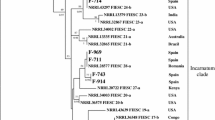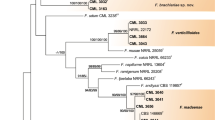Abstract
Fusarium verticillioides(Gibberella moniliformis, G. fujikuroi mating population A) is an important pathogen of maize and produces several mycotoxins, including fumonisins, which cause diseases in humans and animals. The partial sequences of the IGS region (Intergenic Spacer of rDNA units) and the translation elongation factor EF-1α gene of a representative sample (48 strains) of F. verticillioides isolated from diverse hosts, geographical origins and with different levels of fumonisin production were analyzed. A phylogenetic approach by PAUP was used to evaluate the genetic variability in this species and to detect the occurrence of lineages which could be associated with different hosts or produced different toxin profiles within this species. Genetic variability detected by both sequences was high, especially with the IGS sequence which showed a high number of parsimony-informative sites and nucleotide diversity. The results of the phylogenetic analysis indicated that F. verticillioides occurs as (i) a major fumonisin-producing population with a wide geographical distribution, wide host preferences (cereals), showing variability and considerable incidence of sexual reproduction and (ii) a minor fumonisin non-producing population, with restricted host preference (banana), low variability and clonal reproductive strategy.
Similar content being viewed by others
References
Appel DJ and Gordon TR (1995) Intraspecific variation within populations of Fusarium oxysporum based on RFLP analysis of the intergenic spacer region of the rDNA. Experimental Mycology 19: 120-128
Appel DJ and Gordon TR (1996) Relationships among pathogenic and non-pathogenic isolates of Fusarium oxysporum based on the partial sequence of the intergenic spacer region of the ribosomal DNA. Molecular Plant-Microbe Interaction 9: 125-138
Bacon CW and Hinton DM (1996) Symptomless endophytic colonization of maize by Fusarium moniliforme. Canadian Journal of Botany 74: 1195-1202
Desjardins AE and Plattner RD (2000) Fumonisin B(1)-non producing strains of Fusarium verticillioides cause maize (Zea mays) ear infection and ear rot. Journal of Agricultural Food and Chemistry 48: 5773-5780
Excoffier L, Smouse PE and Quattro JM (1992) Analysis of molecular variance inferred from metric distances among DNA haplotypes: Application to human mitochondrial DNA restriction data. Genetics 131: 479-491
Farris JS, Källersjö M, Kluge AG and Bult C (1995) Testing significance of incongruence. Cladistics 10: 315-319
Geiser DM, Pitt JI and Taylor JW (1998) Cryptic speciation and recombination in the aflatoxin-producing fungus Aspergillus flavus. Proceedings of the National Academy of Sciences of the United States of America 95: 388-393
Gelderblom WCA, Jaskiewicz K, Marasas WF, O'Thiel PG, Horak RM, Vleggaar R and Kriek NPJ (1988) Fumonisins-novel mycotoxins with cancer-promoting activity produced by Fusarium moniliforme. Applied and Environmental Microbiology 54: 1806-1811
Hillis DM and Dixon MT (1991) Ribosomal DNA: Molecular evolution and phylogenetic inference. Quarterly Review of Biology 66: 411-453
Hillis DM and Bull JJ (1993) An empirical test of bootstrapping as a method for assessing confidence in phylogenetic analysis. Systematic Biology 42: 182-192
Huss MJ and Leslie JF (1996) Isozyme variation among biological species in the Gibberella fujikuroi species complex (Fusarium section Liseola). Applied and Environmental Microbiology 62: 3750-3756
Jukes TH and Cantor CR (1969) Evolution of protein molecules. In: Munro, HN (ed) Mammalian Protein Metabolism (pp 21–132) Academic Press, New York, USA
Keréngy Z, Zeller K, Hornok L and Leslie JF (1999) Molecular standardization of mating type terminology in the Gibberella fujikuroi species complex. Applied and Environmental Microbiology 65: 4071-4076
Kishino H and Hasegawa M (1989) Evaluation of the maximum likelihood estimate of the evolutionary tree topologies from DNA sequence data, and the branching order in Hominoidea. Journal of Molecular Evolution 29: 170-179
Leslie JF (1995) Gibberella fujikuroi: Available populations and variable traits. Canadian Journal of Botany 73: 5282-5291
Leslie JF and Klein KK (1996) Female fertility and mating type effects on effective population size and evolution in filamentous fungi. Genetics 144: 557-567
Leslie JF, Plattner RD, Desjardins AE and Klittich CJR (1992) Fumonisin B1 production by strains from different mating populations of Gibberella fujikuroi (Fusarium moniliforme). Phytopathology 82: 341-345
Mirete S, Patio B, Vázquez C, Jiménez M, Hinojo MJ, Soldevilla C and González-Jaén MT (2003) Fumonisin production by Gibberella fujikuroi strains from Pinus species. International Journal of Food Microbiology 89: 213-221
Moss MO (1998) Recent studies of mycotoxins. Journal of Applied Bacteriology Symposium Supplement 84: 625-765
Nei M (1987) Molecular Evolutionary Genetics. Columbia University Press, New York
Nelson PE, Desjardins AE and Plattner RD (1993) Fumonisins, mycotoxins produced by Fusarium species: Biology, chemistry, and significance. Annual Review of Phytopathology 31: 233-252
O'Donnell K, Cigelnik E and Nirenberg HI (1998a) Molecular systematics and phylogeography of the Gibberella fujikuroi species complex. Mycologia 90: 465-493
O'Donnell K, Kistler HC, Cigelnik E and Ploetz RC (1998b) Multiple evolutionary origins of the fungus causing Panama disease of banana: Concordant evidence from nuclear and mitochondrial gene genealogies. Proceedings of the National Academy of Sciences of the United States of America 95: 2044-2049
O'Donnell K, Kistler HC, Tacke BK and Casper HH (2000a) Gene genealogies reveal global phylogeographic structure and reproductive isolation among lineages of Fusarium graminearum, the fungus causing wheat scab. Proceedings of the National Academy of Sciences of the United States of America 97: 7905-7910
O'Donnell K, Nirenberg HI, Aoki T and Cigelnik E (2000b) A multigene phylogeny of the Gibberella fujikuroi species complex: Detection of additional phylogenetically distinct species. Mycoscience 41: 61-78
Rozas J and Rozas R (1999) DnaSP Version 3: An integrated program for molecular population genetics and molecular evolution analysis. Bioinformatics 15: 174-175
Schneider S, Kueffer JM, Roessli D and Excoffier L (1997) ARLEQUIN Version 1.1: A software for population genetic data analysis. Genetics and Biometry Lab, Department of Anthropology, University of Geneva, Geneva, Switzerland
Seo J, Proctor RH and Plattner RD (2001) Characterization of four clustered and coregulated genes associated with fumonisin biosynthesis in Fusarium verticillioides. Fungal Genetics and Biology 34: 155-165
Steenkamp ET, Wingfield BD, Desjardins AE, Marasas WFO and Wingfield MJ (2002) Cryptic speciation in Fusarium subglutinans. Mycologia 94: 1032-1043
Swofford DL (2002) PAUP*. Phylogenetic Analysis Using Parsimony (*and other methods). Version 4. Sinauer Associates, Sunderland, Massachusetts, USA
Taylor JW, Jacobson DJ and Fisher MC (1999) The evolution of asexual fungi: Reproduction, speciation and classification. Annual Review of Phytopathology 37: 197-246
Templeton AR (1983) Phylogenetic inference from restriction endonuclease cleavage site maps with particular reference to the human and apes. Evolution 37: 221-244
Author information
Authors and Affiliations
Corresponding author
Rights and permissions
About this article
Cite this article
Mirete, S., Vázquez, C., Mulè, G. et al. Differentiation of Fusarium verticillioides from Banana Fruits by IGS and EF-1α Sequence Analyses. European Journal of Plant Pathology 110, 515–523 (2004). https://doi.org/10.1023/B:EJPP.0000032391.38512.f8
Issue Date:
DOI: https://doi.org/10.1023/B:EJPP.0000032391.38512.f8




